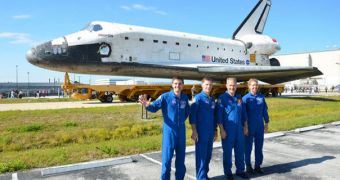At this point, the American space agency is targeting a July 8 launch date for the STS-135 mission, which will be carried out by space shuttle Atlantis. A formal launch date will be established following the June 28 Flight Readiness Review mission planners will conduct.
Originally, the orbiter was supposed to launch on its final flight in late June, but delays that plagued shuttle Endeavour's launch forced NASA to reschedule. Originally supposed to take off on April 19, Endeavour launched to the International Space Station on May 16.
As far as Atlantis goes, it too will take off from the Launch Pad 39A facility, at the Kennedy Space Center (KSC), in Florida. A window of opportunity opens up at around 11:40 am EDT (1540 GMT).
STS-135 will last for only 12 days, as opposed to the 16 days Endeavour is spending in space during its ongoing mission, STS-134. Additionally, Atlantis will only carry four astronauts, rather than the usual crew of 6 or 7, Space reports.
Once docked to the ISS, the orbiter will deliver supplies, spare parts, scientific experiments and personal items for the astronauts of Expedition 28. There are no extravehicular activities planned for the spacecraft's final flight.
The upcoming mission will also mark the end of the NASA Space Shuttle Program (SSP), which has been in operations for more than 30 years. Once the three-orbiter fleet is retired, the United States will lose the ability to reach the ISS with either astronauts or cargo.
Given the massive amount of material that can fit inside a shuttle cargo bay, it makes sense for Atlantis to only carry supplies, rather than a large components. For example, Endeavour carried the huge, $2 billion Alpha Magnetic Spectrometer (AMS) particle detector as it launched.
However, Atlantis too will be carrying an interesting, but smaller, experiment, whose purpose, NASA officials say, is to “demonstrate and test the tools, technologies and techniques needed to robotically refuel satellites in space – even satellites not designed to be serviced.”
The experiment, called the Robotic Refueling Mission (RRM), was developed by scientists with the Satellite Servicing Capabilities project, which is being developed at the NASA Goddard Space Flight Center (GSFC), in Greenbelt, Maryland.
On its trip back home, Atlantis will return the failed ammonia pump module that gave ISS controllers a real scare in 2010. The component broke down at one point, leaving half of the station without cooling.
The hardware will be returned to Earth for analysis, so that engineers can root out the underlying problem. Accompanying the module in Atlantis' Multi-Purpose Logistics Module (MPLM) will be the problematic Common Cabin Air Assembly (CCAA) Heat Exchanger (HX).
During STS-135, the mission will be manned by veteran NASA astronauts Christopher Ferguson (Commander), Douglas Hurley (Pilot), and mission specialists Sandra Magnus and Rex Walheim.

 14 DAY TRIAL //
14 DAY TRIAL //